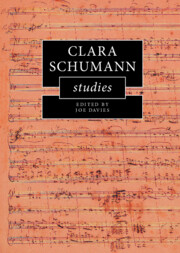Book contents
- Clara Schumann Studies
- Cambridge Composer Studies
- Clara Schumann Studies
- Copyright page
- Dedication
- Contents
- Figures
- Tables
- Music Examples
- Contributors
- Acknowledgements
- Introduction: Clara Schumann in the Musicological Imagination
- 1 Clara and Robert Schumann’s Circles in Dresden
- 2 Disillusionment and Patriotism
- 3 Softened, Smudged, Erased
- 4 A Way with Words
- 5 Clara Schumann and the Nineteenth-Century Piano Concerto
- 6 Clara Schumann and Bach
- 7 Formal Innovation and Virtuosity in Clara Schumann’s Piano Trio in G minor, Op. 17
- 8 Contextualizing Clara Schumann’s Romanzen
- 9 The Young Prophetess in Performance
- 10 Clara Schumann’s Compositional and Concertizing Strategies, and Robert Schumann’s Piano Sets
- 11 Clara: Robert’s Posthumous Androgyne
- 12 Clara Schumann, ‘Clara Schumann’ and the American Press
- 13 Clara Schumann’s Legacy As a Teacher
- Select Bibliography
- Index
6 - Clara Schumann and Bach
Published online by Cambridge University Press: 25 November 2021
- Clara Schumann Studies
- Cambridge Composer Studies
- Clara Schumann Studies
- Copyright page
- Dedication
- Contents
- Figures
- Tables
- Music Examples
- Contributors
- Acknowledgements
- Introduction: Clara Schumann in the Musicological Imagination
- 1 Clara and Robert Schumann’s Circles in Dresden
- 2 Disillusionment and Patriotism
- 3 Softened, Smudged, Erased
- 4 A Way with Words
- 5 Clara Schumann and the Nineteenth-Century Piano Concerto
- 6 Clara Schumann and Bach
- 7 Formal Innovation and Virtuosity in Clara Schumann’s Piano Trio in G minor, Op. 17
- 8 Contextualizing Clara Schumann’s Romanzen
- 9 The Young Prophetess in Performance
- 10 Clara Schumann’s Compositional and Concertizing Strategies, and Robert Schumann’s Piano Sets
- 11 Clara: Robert’s Posthumous Androgyne
- 12 Clara Schumann, ‘Clara Schumann’ and the American Press
- 13 Clara Schumann’s Legacy As a Teacher
- Select Bibliography
- Index
Summary
Until the recent emergence of women composers from the shadows, the name Schumann coupled with that of Bach in the context of compositional influence would have been taken to indicate Robert Schumann. However, their marriage diaries reveal that Robert and Clara Schumann were involved in studying together the music of Johann Sebastian Bach, specifically the two books of his ‘Forty-Eight’ Preludes and Fugues. This chapter first explores some implications of the documentary evidence of Robert and Clara Schumann’s engagement with J. S. Bach’s music, as well as Clara Schumann’s perception of her compositional efforts. The case studies that follow consider the impact of Bach on Clara Schumann as a composer, focusing on her Three Preludes and Fugues, Op. 16 (especially No. 1 in G minor) and her Piano Trio in G minor, Op. 17 (with particular reference to the first movement and finale), and ranging from direct connections to broader compositional traits. Comparison with Robert Schumann’s fugal writing proves revealing with reference to the finale of his Piano Quintet in E flat major, Op. 44, and the finale of Clara’s Piano Trio. Concluding remarks explore the nature of intertextuality, and the wider context of nineteenth-century Bach culture in relation to the work of women composers.
Keywords
- Type
- Chapter
- Information
- Clara Schumann Studies , pp. 117 - 138Publisher: Cambridge University PressPrint publication year: 2021

